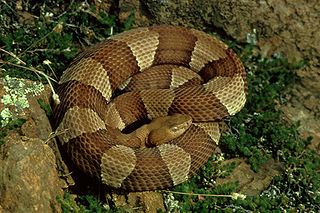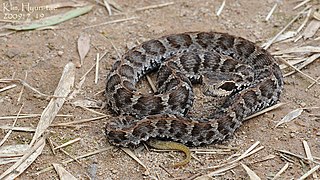
The eastern copperhead, also known as the copperhead, is a species of venomous snake, a pit viper, endemic to eastern North America; it is a member of the subfamily Crotalinae in the family Viperidae.

Agkistrodon piscivorus is a species of pit viper in the subfamily Crotalinae of the family Viperidae. It is one of the world's few semiaquatic vipers, and is native to the southeastern United States. As an adult, it is large and capable of delivering a painful and potentially fatal bite. When threatened, it may respond by coiling its body and displaying its fangs. Individuals may bite when feeling threatened or being handled in any way. It tends to be found in or near water, particularly in slow-moving and shallow lakes, streams, and marshes. It is a capable swimmer and, like several species of snakes, is known to occasionally enter bays and estuaries and swim between barrier islands and the mainland.

Agkistrodon is a genus of venomous pit vipers commonly known as American moccasins. The genus is endemic to North America, ranging from the Southern United States to northern Costa Rica. Eight species are currently recognized, all of them monotypic and closely related. Common names include: cottonmouths, copperheads, and cantils.

The western cottonmouth was once classified as a subspecies of the cottonmouth. However, DNA based studies published in 2008 and 2015, revealed no significant genetic difference between the eastern cottonmouth and the western cottonmouth and synonymized the two subspecies. The resulting taxonomy does not recognizes the western cottonmouth as a valid taxon. Several subsequent reviews and species accounts have followed and supported the revised taxonomy. Information on this snake can be found in the Agkistrodon piscivorus article.

Agkistrodon taylori is a species of venomous snake, a pitviper (Crotalinae) found only in northeastern Mexico. The standardized names are Taylor's cantil (English) and Metapil (Spanish), although it is sometimes called the ornate cantil as well as several other colloquial names. It was named in honor of American herpetologist Edward Harrison Taylor.

Gloydius blomhoffii, commonly known as the mamushi, Japanese moccasin, Japanese pit viper, Qichun snake, Salmusa or Japanese mamushi, is a venomous pit viper species found in Japan. It was once considered to have 4 subspecies, but it is now considered monotypic.

Agkistrodon bilineatus is a highly venomous pit viper species found in Mexico and Central America as far south as Honduras.

The Florida cottonmouth is a species of venomous snake, a pitviper in the subfamily Crotalinae of the family Viperidae. The species is endemic to the United States, where it occurs in southern Georgia and the Florida peninsula in nearly every type of wetlands in the region, including brackish water and offshore islands. However, it is not entirely dependent on water and is occasionally encountered as far as a mile from surface water. Agkistrodon conanti venom is very hemolytic and known to cause relatively extensive necrosis compared to many snake venoms, and can sometimes be lethal with a 17% mortality rate. It is often confused with harmless watersnakes (Nerodia) and other semi-aquatic species with which it shares its habitat.

Agkistrodon laticinctus, commonly known as the broad-banded copperhead, is a venomous pit viper species, formerly considered a subspecies of Agkistrodon contortrix, which is found in the southern United States, from Kansas, through Oklahoma and throughout central Texas.

Agkistrodon piscivorus piscivorus was formerly a venomous pitviper, one of three subspecies of Agkistrodon piscivorus, with different geographic distributions, found in the southeastern United States. However, recent taxonomic changes do not recognizes any subspecies of cottonmouth as a valid taxa.

Agkistrodon contortrix mokasen was formerly a venomous pit viper subspecies found in the eastern United States. However, recent taxonomic changes do not recognize the northern copperhead as a valid taxon.

Agkistrodon contortrix phaeogaster was formerly a venomous pit viper subspecies found in the central region of the United States. However, recent taxonomic changes do not recognizes the Osage copperhead as a valid taxon.
Agkistrodon howardgloydi is a species of venomous snake, a pit viper (Crotalinae), that is endemic to Central America. It is most commonly called castellana,but it has also been called the southern cantil, Gloyd's moccasin, and a number of other colloquial names. It is a rare species with a relatively small geographic distribution in the tropical dry forest on the Pacific coast of Honduras, Nicaragua, and extreme northwest Costa Rica. Agkistrodon howardgloydi is a stout, medium-sized snake with a maximum length of 96 cm. It is a viviparous species, with female giving birth in the rainy season from May to August. No clinical reports on envenomation had been published, but laboratory texts and analysis indicate the venom is highly toxic and similar to its close relative Agkistrodon bilineatus, and potentially lethal.
Agkistrodon russeolus, commonly called the Yucatecan cantil, is a venomous pit viper species endemic to the Yucatán Peninsula in Mexico and northern Belize.
Hypnale walli, or Wall's hump-nosed viper, is a venomous pitviper species endemic to Sri Lanka. The smallest member of its genus, it is distinguished by having a strongly upturned nose and lower scale counts. No subspecies are currently recognized.

Gloydius intermedius is a venomous pitviper species endemic to northern Asia. Three subspecies are currently recognized, including the nominate subspecies described here.
Gloydius shedaoensis is a venomous pitviper species found only on Shedao Island in China. Although very small, this island is home to an extraordinarily large population of these snakes. No subspecies are currently recognized.
Gloydius strauchi is a species of venomous pit viper in the subfamily Crotalinae of the family Viperidae. The species is native to western China. It is a small snake with a pattern of four longitudinal stripes, although some older specimens may be a uniform black. G. strauchi may be distinguished from G. monticola by its higher midbody dorsal scale count. This species jointly holds the altitude record for pitvipers together with Crotalus triseriatus of Mexico, both being found even above the tree line at over 4,000 m (13,000 ft). No subspecies were recognized as being valid, until a recent publication re-evaluated the taxonomic statuses of populations of G. strauchi and described the eastern Tibetan populations as a new species.

Gloydius ussuriensis is a venomous pitviper species endemic to far east Russia, northeastern China and the Korean Peninsula. No subspecies are currently recognized.

Gloydius brevicauda is a venomous pitviper species endemic to China and the Korean Peninsula.














